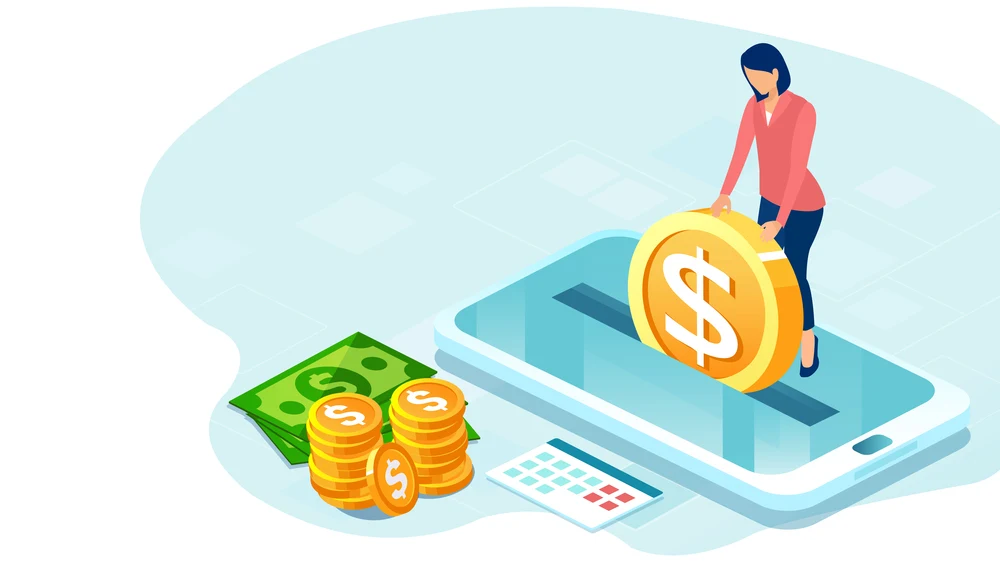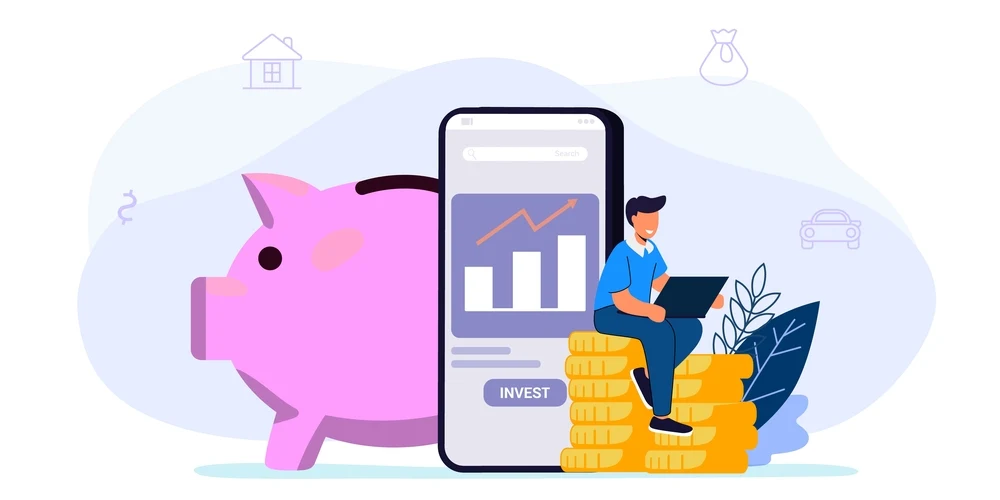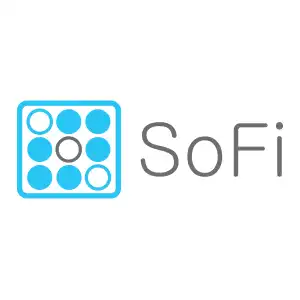As the name suggests, micro-investing apps allow investors to invest a small amount of money. Sometimes you can even invest spare change. It sounds unreal or like it can’t amount to much, but the best investing apps make it easy to invest whether you’re a beginner or an experienced investor.
Table of Contents
What Are Micro Investing Apps?
Sometimes you don’t have enough money to buy high-value stocks or mutual funds, but you still want to invest. Micro investment apps allow you to invest with little money, sometimes as little as $1.
Even though investing a few dollars doesn’t seem like much, it adds up, especially with the earnings, allowing you to grow your net worth even if you don’t have much money to invest.
Each micro-investing app works differently, but most allow you to link a debit card or credit card to your account and round up your purchases to the nearest dollar. The ‘spare change’ is then invested on your behalf.
Micro investing apps take the thinking out of investing. They make it easy to invest money without even realizing it because who misses spare change from their checking account?
Pros and Cons of Micro Investing Apps
Before you invest with a micro-investing app, it’s important to understand the pros and cons to see if micro-investing is right for you.
Pros:
- It’s easy. You don’t have to think about investing or budgeting for it. Micro investing platforms do it for you, rounding up your purchases and investing the difference. It might be only $0.50, but every penny matters.
- You can set it and forget it. You don’t have to fuss with your account much. Once you set up your account with your timeline, risk tolerance, and financial goals, the app does everything else for you while you sit back and relax.
- You don’t need a lot of capital to start. Micro investing platforms allow users to start with as little as $1. This opens up the possibility of investing to many more people, whether you invest in the stock market or elsewhere.
Cons:
- You might not invest enough. If you only invest money using micro-investing platforms, you might not reach your financial goals. They can be a great way to get your feet wet, but they shouldn’t be the only way you invest.
- The fees increase if you invest a lot. If you take the investment advice that you need to invest more than spare change, you might end up paying hefty fees once your balance reaches a certain threshold.
- Most micro-investing apps only have the option for a taxable brokerage account. You can’t take advantage of tax-advantaged retirement accounts.
Features to Look For in Micro Investing Apps
If you’ve decided to try micro-investing, knowing what to look for in the best micro-investing apps is essential. Consider these features.
Ease of Use
No one wants a complicated platform that makes investing even more confusing than it already is. So instead, look for a micro-investing app that is easy to set up, use, and understand when you view your dashboard and try to figure out how your investments are performing or how much you’re paying in fees.
Features
Think about what you want from a micro-investing app. Do you want the app to transfer funds from your funding account automatically? Some popular apps transfer money each time you make a purchase, and others transfer it on a specific date.
Educational resources are also an excellent feature to look for, especially for young investors. Just starting out investing can be confusing, but with the right educational resources, you can learn as you go and grow your knowledge of investments.
Other features to consider include additional financial products or features, budgeting options, and money management features. While these aren’t necessary, they are nice to have when managing your money all in one place.
Cost
Most micro-investing apps don’t have high fees, but knowing the full cost before investing is important. For example, ask about trading fees, commissions, or monthly maintenance fees. Even a small percentage can take away from your earnings, making it harder to reach your financial goals.
While no apps are free (they have to stay in business), you should look for the apps with the lowest costs.
Investing Style
The term investing style refers to whether the app is an active or passive investment. An active investment app means you are in charge of watching your investments, changing allocations as necessary, and making decisions as you go.
A passive investment account means you sit back and let the app do the work for you. Your only responsibility is to answer questions when you open an account, and the app then does the rest for you.
Low Minimum Investments
You are looking at the best micro-investing apps for a reason. You probably don’t have a lot of money to invest. So you want an app that has low minimum investment requirements, which includes the balance they require you to carry.
Look at any minimums they require, such as minimum initial investment or minimum monthly balances.
Recurring Transactions
If you want a truly passive investment account, look for recurring transfers. In other words, you set up an amount to be transferred on the same day each month and in the same amount. Of course, you should be able to change it, but knowing that it’s automatically set can help make investing easier.
Money Management Services
Some investment apps have money management options such as spending or cash management accounts. These are separate from your investment portfolio, but sometimes, it’s nice to have all your money in one place.
Other Banking Services
Some investment apps offer checking accounts, savings accounts, and even loans. This makes it easier to keep track of your financial accounts in one place rather than having them all over.
Diversified Portfolios
A diversified portfolio is the best way to offset a total loss. When one investment does poorly, another may do well, offsetting the loss of the other investment. There’s never a guarantee that any investment will do well, but you increase the chances of higher returns when you diversify.
Educational Tools
Educational tools, especially for beginner investors, are a great way to grasp how to invest. You’ll get sound investment advice that you can use to learn more about investing without paying a financial advisor for it.

8 Best Micro Investing Apps
1. SoFi Invest
SoFi Invest is excellent for investors who don’t want to bother with account fees or even trading fees. Instead, you can choose an actively or passively managed investment account, which includes the option to open a retirement account versus a taxable investment account.
You can invest in fractional shares if you don’t have enough to purchase a full share, and all investors have access to free investment advice from financial advisors.
You can set up automatic transfers from your purchases by rounding up or making one-time deposits to increase your investment amount.
To start investing with SoFi, you need just $5. Click here to open an account.
A financial service and brokerage company that aims to help you on your financial journey. Whether you are looking for a checking, savings, loans, refinancing, and more SoFi has what you need.
- No Monthly Maintenance Fees
- No Overdraft Fees
- Good APY
- ATM Fee-Free Access
- No Minimum to Open
- No Branch Locations
2. M1 Finance
M1 Finance is a great personal finance app that provides you with the ability to invest, save, build wealth, and it even includes a debit card. M1 is a cross between an active and passive investment app.
When you open an account, you pick your stock and index funds and then sit back and ‘forget it.’ Instead, the app automates investments, so you don’t have to do anything except make sure there are funds in your account before M1 transfers them to your portfolio.
M1 offers automatic rebalancing when your portfolio gets off track, and if you deposit at least $1,000, they often pay a signup bonus.
To take advantage of this high-powered app that provides many investment options, educational tools, and commission-free trades, click here to sign up.
Manage and grow your wealth with M1 FInance. Founded in 2015, M1 has brokerage accounts, checking accounts, and lines of credit. The site (and app) offer wealth building for today's long-term investors.
- Customizable portfolio management tools
- No fees for account management or trading
- Mix Funds - Stocks and ETFs
- Low minimum investments
- Partial Shares
- No Tax Loss Harvesting
- No financial planning or advisory services
3. Acorns
Acorns is the original micro-investing app to offer the opportunity to round up your purchases to the nearest dollar and invest the spare change. An Acorns account is perfect for the beginning investor that doesn’t have any money to invest right now but can afford the change Acorns invests.
There aren’t any trading fees, but Acorns does charge monthly fees between $3 – $5 a month, depending on if you want a personal or family account. You’ll get a taxable investment account, a retirement savings account, and a bank account with each.
Each account comes with a debit card that you can use to earn ‘cash back’ rewards, but instead of cash in your bank account, they’ll invest the funds for you.
Acorns is an easy-to-use app that will help you invest your money, save and spend smarter for just $3 per month. Start your wealth-building journey with Acorns today.
- Cashback at select retailers
- Save spare change - automatically
- Content available for education
- Fees on account balances - frees can be high
4. Public.com
Public.com is the social media version of investing. If you’re interested in other people’s investment strategies or want to follow what others do, Public.com makes it easy to interact and invest simultaneously.
With Public.com, all portfolios are public, so you can see what others are doing. This is a great app for beginners who are gun shy about starting but want to get started. The open forum makes it easy to ask questions of other investors, and its populated feed sends you investments you might be interested in to help you learn about your options and make more informed choices.
Public.com offers its investments in themes, though, versus portfolios. For example, you can choose from themes like healthcare or stay-at-home parent. Before investing, you can see the companies within each theme to decide if they fit in with what you believe in, such as socially responsible investing.
To invest with Public.com, you must download their app on your smartphone.
With Public, you can Invest in stocks, funds, and cryptocurrencies - all in one place! Follow other investors, invest with context, and build your ideal portfolio!
- Fractional Shares
- Variety of Educational Learning Tools
- Free Research and Analytics Tools
- Variety of Trading, Including Cryptocurrencies
- Supportive Community
- Mobile Platform (App-based)
- No Futures, Margins, or Options trading
- Limited Account Types
- Required Fee for Access to Advanced Analytic Data
5. Greenlight
Greenlight is a micro-investing app for minors. If you want to give your child early exposure to investing, this is one of the best micro-investing apps for you.
Before you set your child up on Greenlight, know that a parent or grandparent must be the custodian and link their bank account to the app. Fortunately, all investments must get parental approval before kids can make decisions, so it helps you learn about your child’s investment strategies and how to make financial decisions.
Kids need only $1 to start, and there aren’t any trading commissions, but there is a monthly fee. Kids can invest in stocks and ETFs, including fractional shares, to make the most of their money.
To get your child started with investing, click here and enter your mobile number.
6. Robinhood
Robinhood started the commission-free trend, and now many other investment apps have joined the movement. On Robinhood, investors can trade stocks, cryptocurrency, options, and ETFs. It can be a little overwhelming for beginning investors, but it’s a great option for experienced investors looking for a cross between a micro-investing app and a standard investment app.
Robinhood is user-friendly and offers the option for self-directed investing. Investors can buy fractional shares, and you can access your account on your smartphone or computer.
To open an account with Robinhood, download the app on your iOS or Android phone and sign up for an account.
Over 18 million users trust Robinhood for stock and cryptocurrency investing. Build your investment portfolio & earn a guaranteed stock when you sign up and link your bank account.
- Commission-free Trades
- Intuitive Tools & Market Insight
- Very User Friendly Mobile App
- No Access To Mutual Funds
7. Betterment
Betterment is for the investor looking for strictly exchange-traded funds, and that’s worried about tax-loss harvesting. Unfortunately, not all investing apps offer tax-loss harvesting, which is a way to reduce your tax liabilities by selling an asset at a loss to offset the capital gains on another asset.
Betterment immediately diversifies your account, but they charge 0.25% of your assets under management to manage your account. Betterment helps you create a viable investing strategy after asking some pointed questions about your goals and risk tolerance to help you build the portfolio to help you reach your goals.
Click here to sign up for an account.
8. Stash
Stash is a great all-in-one investing app. It provides not only the option for micro-investing but also provides banking features, including a checking account.
Stash is a hands-off investment app, but you can choose your stocks if you wish. With Stash, you can spend money in your spend account and set up recurring deposits to continually invest your money.
You can open a taxable brokerage account or even an IRA (traditional or Roth). If you have children under 18, they also offer custodial accounts that include a debit card and $10,000 in no-cost life insurance for up to 2 children.
Stash costs between $ 1- $9 a month, and you need $5 to open an account. If you deposit at least $5 when you open your account, Stash will match your contribution, doubling your balance immediately.
To open an account, click here and enter your email address and a password to start.
Warnings About Micro Investing Apps
Know the risks before jumping on board with any micro-investment app. There’s always a risk of loss, as is the case with any investment app, but there’s also the chance of getting reckless.
When you’re only investing a couple of dollars or spare change, you might get brave with your investing strategy, taking risks you wouldn’t usually take. But instead, take it slow and stay as conservative as possible until you get the hang of things and truly know what you want out of the app.
Even if it feels like a game or as if it’s pretend, you are investing real money and could lose a lot if you aren’t careful.

Micro Investing Apps FAQ
How Much Money Do You Need to Access a Micro Investing App?
Some micro-investment apps require investments as low as $1, and most don’t have a monthly minimum balance requirement. This makes it easier for beginners to start investing, but you should also research any micro-investment apps you consider to ensure they are safe, easy to use and provide the investments you want.
Can You Make Money Micro-Investing?
There’s always the chance you can make money or lose money with even the best micro-investing app. It comes down to how well you diversify your portfolio, protect your investments, and reallocate your funds if they get off balance.
Even though you’re only investing a small amount of money, it can add up fast, especially if you leave it invested for the long-term and let your money grow.
How Much Does Micro-Investing Cost?
Many micro-investing apps don’t have a monthly fee or even trading fees. Others, however, have monthly subscription fees or charge you a percentage of your assets under management. In addition, most micro-investment apps also have ETF load fees or other service fees that you should look for before investing.
Can You Buy Fractional Shares of Stock With Micro-Investing?
Many micro-investment apps do allow you to buy fractional shares. This means, for example, if you can’t afford a total share of Amazon, you can buy a fraction of it and still take part in its earnings should the stock do well.
Why Do People Like Micro Investing?
Investors like micro-investing because it doesn’t require a lot of capital, and you can automate your investments. Many apps also offer automatic portfolio reallocations giving investors a completely hands-off approach to investing.
Is Micro Investing a Good Idea?
If you’re just starting out investing or you have a hard time staying consistent, micro-investing platforms can be a great way to get started or remain consistent. You either round up your purchases or set up automatic transfers so that you always invest, even if it’s only a small amount of money.
The Bottom Line
Micro investing apps can be a great way to get your feet wet with investing, or they can be a great addition to any other investment portfolios you have. If you’re looking for hands-off investing that offers fractional shares and automated investing options, consider your options for micro-investing platforms.
Samantha Hawrylack is a personal finance expert and full-time entrepreneur with a passion for writing and SEO. She holds a Bachelor’s in Finance and Master’s in Business Administration and previously worked for Vanguard, where she held Series 7 and 63 licenses. Her work has been featured in publications like Grow, MSN, CNBC, Ladders, Rocket Mortgage, Quicken Loans, Clever Girl Finance, Credit Donkey, Crediful, Investing Answers, Well Kept Wallet, AllCards, Mama and Money, and Concreit, among others. She writes in personal finance, real estate, credit, entrepreneurship, credit card, student loan, mortgage, personal loan, insurance, debt management, business, productivity, and career niches.






